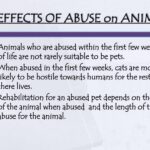Animal cruelty is a pressing issue that weaves a dark thread through the fabric of society, casting a shadow over countless innocent lives. The journey toward alleviating such inhumane treatment is akin to navigating an intricate labyrinth, where progress is often thwarted by formidable challenges. Yet, there is a flicker of hope as organizations, individuals, and legislation come together to forge a path toward a more compassionate world for our fellow beings.
The fight against animal cruelty has garnered significant traction over the past decades, leading to notable advancements in public awareness, legal protections, and rehabilitation efforts. Campaigns and movements aimed at educating the public have burgeoned, transforming apathy into empathy. Social media platforms serve as powerful megaphones, amplifying voices that advocate for the voiceless. Video footage of neglect and abuse has become a rallying cry, galvanizing communities to action. These digital sparks ignite a firestorm of outrage, compelling many to reconsider the ethics of their interactions with animals.
Legal frameworks have evolved, albeit unevenly, across different jurisdictions. Several countries, states, and municipalities have enacted stringent animal cruelty laws, reflecting a shift in societal values. The introduction of felony charges for severe cases and the establishment of harsher penalties for abusers serve as a testament to a growing acknowledgment of animal sentience. Compulsory reporting laws have also emerged, placing the onus on veterinarians and pet professionals to report suspected abuse. These legislative measures, however, often struggle against a backdrop of enforcement challenges. The sheer volume of cases, along with a lack of resources for proper investigation, remains a significant hurdle.
In tandem with legal advancements, grassroots movements are cultivating a culture of compassion. Organizations dedicated to rescue and rehabilitation of abused animals, such as shelters and sanctuaries, have proliferated. These sanctuaries serve as safe havens, where resilience blooms amidst the scars of past traumas. Here, animals are not merely saved but individuals are nurtured back to health, finding solace in an environment that prioritizes their well-being. The journeys of these animals are testaments to the strength of the human-animal bond, illustrating that recovery is not merely a possibility but a reality.
Yet, these strides forward are not without their challenges. The public’s growing awareness can sometimes tip into sensationalism, where the focus on extreme cases overshadows the daily, less visible suffering faced by many animals. While shocking images of cruelty capture attention, they rarely address the underlying societal structures—poverty, ignorance, and neglect—that foster such environments. This narrative often leads to empathy fatigue, where the audience becomes desensitized and less inclined to engage with ongoing issues.
Moreover, entrenched cultural practices and economic interests pose formidable barriers to meaningful reform in certain regions. The commercialization of animal products continues to perpetuate systems that prioritize profit over welfare. Practices like factory farming, where animals are viewed as mere commodities, reflect a systemic disregard for their inherent value. Changing these deep-rooted practices necessitates more than just legislation; it calls for a cultural revolution that redefines human-animal relationships. Educational initiatives aimed at fostering compassion from an early age are paramount in this regard.
Collaboration among various stakeholders is essential to address these multifaceted challenges. Non-profits, governmental agencies, and corporate entities must forge alliances to create comprehensive solutions. The emergence of ethical consumerism, where individuals demand humane treatment of animals, has prompted businesses to reevaluate their practices. This consumer-driven change is facilitating a gradual shift in industries traditionally resistant to reform. However, the onus remains on consumers to remain informed and conscientious in their choices, as market demand sets the tone for industry standards.
Additionally, enhancing the field of veterinary medicine plays a pivotal role in the fight against animal cruelty. Veterinary professionals are at the frontline, wielding the dual responsibility of caring for animals and identifying signs of abuse. Their training must encompass not only clinical skills but also education regarding the ethical implications of their work. By empowering veterinary staff with the tools necessary to recognize and report animal cruelty, the veterinary community can be a powerful ally in the fight against injustice.
The interplay between progress and challenges in addressing animal cruelty is a complex tapestry, woven with threads of innovation and adversity. The fight is ongoing, and each victory, no matter how small, is a step toward a larger paradigm shift. It is critical to remain vigilant, recognizing that progress may be incremental but is not unceasing. The willingness to confront discomfort, challenge the status quo, and foster empathy will determine if we can rewrite the narrative of animal cruelty into one of hope and healing.
In conclusion, the commitment to combat animal cruelty is a call to arms for society as a whole. It requires the collective effort of individuals, communities, and institutions to create a future where every creature, regardless of its circumstances, is treated with dignity and respect. The metamorphosis from a society plagued by cruelty to one characterized by compassion is fraught with challenges, yet it is an endeavor worth pursuing. The journey may be long and arduous, but it is a journey toward a more humane existence, reflecting the best of our collective conscience.







